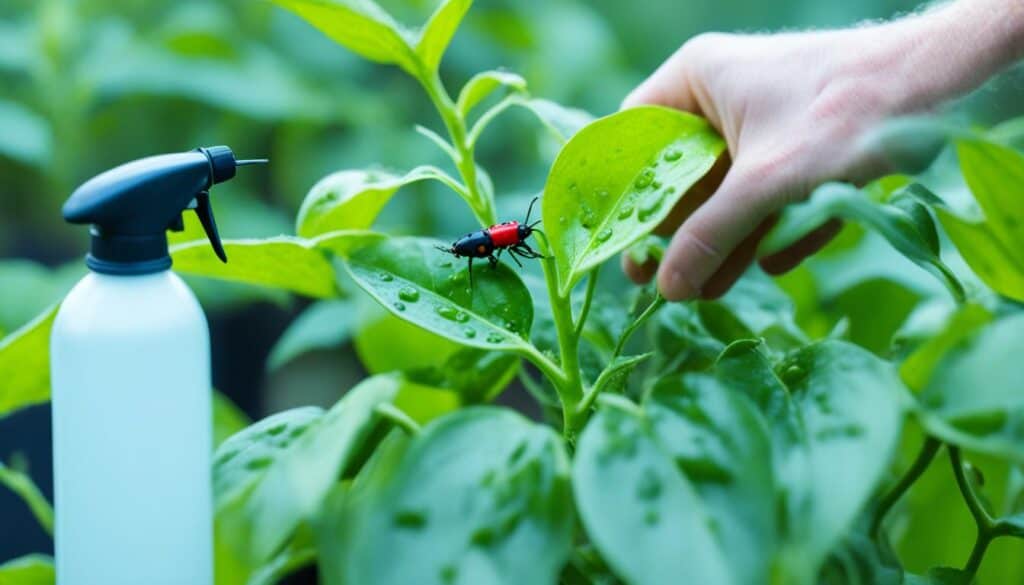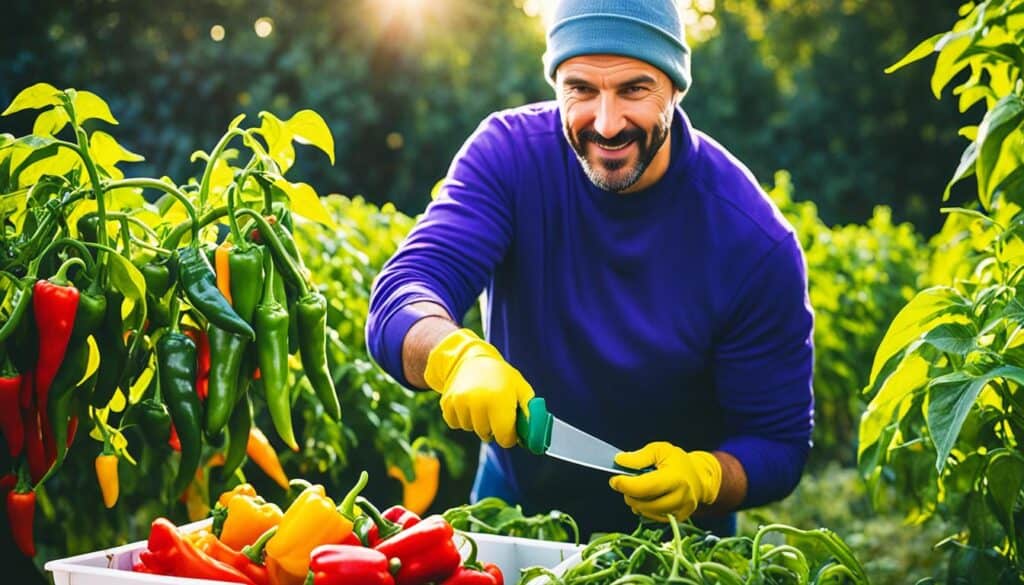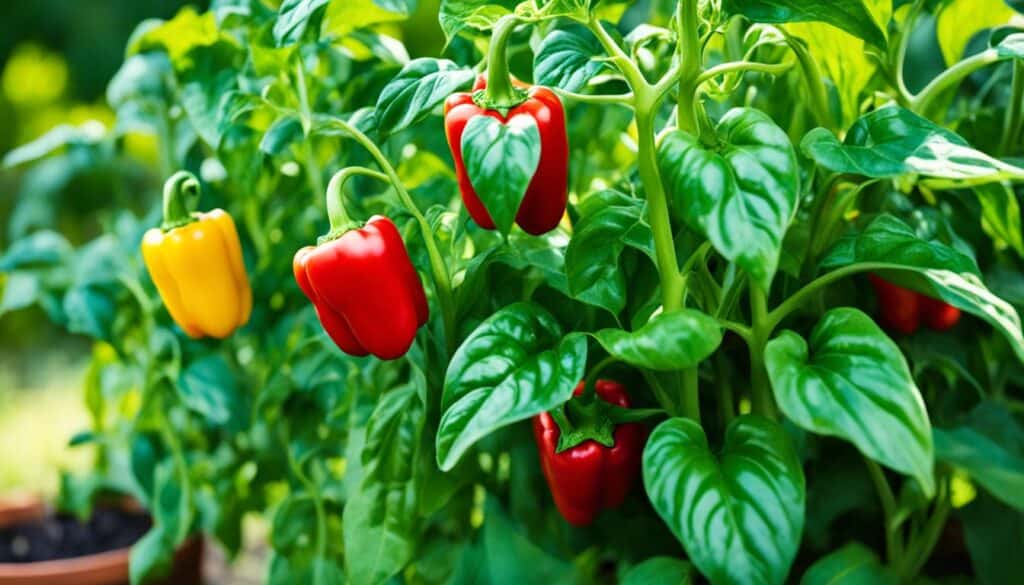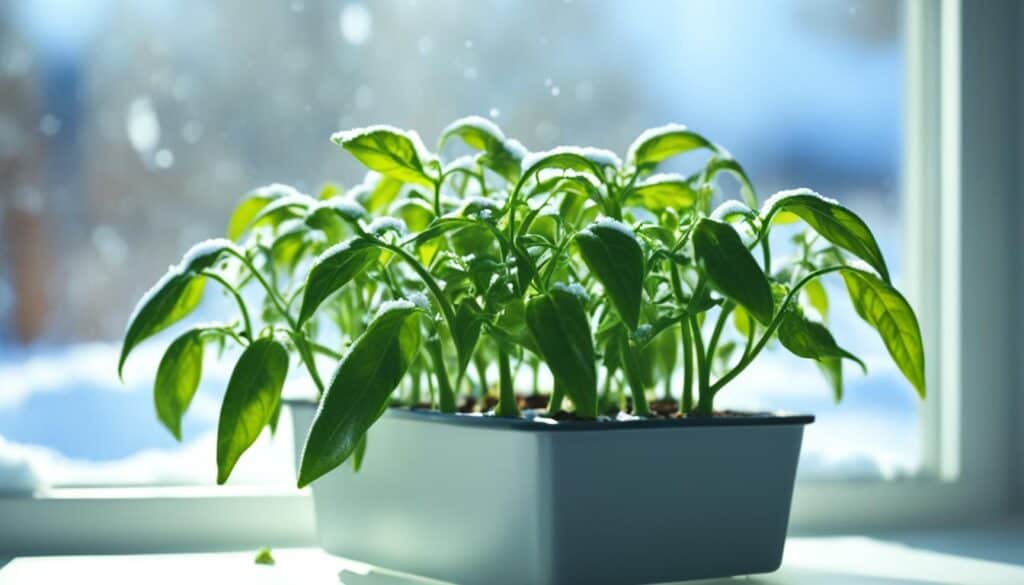Did you know that hot peppers, such as jalapenos and habaneros, are not only fiery and flavorful additions to your meals, but they are also packed with health benefits? These spicy peppers contain a compound called capsaicin, which has been shown to have anti-inflammatory and pain-relieving properties. In fact, studies have found that consuming hot peppers can help reduce the risk of chronic diseases like heart disease and cancer.
Key Takeaways:
- Growing peppers can provide you with a bountiful harvest of delicious and healthy fruits.
- Hot peppers, like jalapenos and habaneros, are rich in capsaicin, a compound that offers numerous health benefits.
- Peppers thrive in sunny locations and require fertile soil with good drainage.
- Regular watering, mulching, and proper fertilization are essential for the successful growth of pepper plants.
- Harvest peppers when they reach the desired size and color, and enjoy them fresh or preserved in various ways.
Planting Peppers: Location and Soil Preparation
Growing peppers requires careful consideration of the planting location and soil preparation. In this section, I will guide you through the essential steps to ensure your pepper plants thrive and produce a bountiful harvest.
Choosing the Right Location
Peppers are sun-loving plants, and they require at least 6-8 hours of direct sunlight per day to grow vigorously. When selecting a planting spot, choose an area in your garden that receives ample sunlight.
It’s also important to provide protection from strong winds, as pepper plants can be susceptible to wind damage. Consider planting them near a fence, wall, or other structures that can offer shelter.
Preparing the Soil
Fertile soil with good drainage is crucial for pepper plants to thrive. Before planting, it’s recommended to amend the soil with organic matter such as compost.
Amending the soil with compost can increase nutrient levels, particularly potassium, phosphorus, and calcium, which are essential for healthy pepper growth.
Here’s a step-by-step guide for prepping your soil:
- Clear the area of any weeds or debris.
- Loosen the soil using a garden fork or tiller to improve its texture and ensure adequate drainage.
- Add a generous layer of compost to the soil and mix it thoroughly to distribute nutrients evenly.
By creating a nutrient-rich and well-draining environment, you’ll provide your peppers with the ideal conditions for growth.
Optimizing for Wet Climates
In wet climates, it’s important to provide ample air flow around each pepper plant to reduce disease pressure caused by excessive moisture.
You can achieve this by spacing the plants adequately and avoiding overcrowding. Consider using stakes or cages to support the plants and prevent them from leaning into each other.
With the right location and well-prepared soil, your pepper plants will have a strong foundation and be ready to flourish.
| Key Points | Benefits |
|---|---|
| Choosing a sunny location | Ensures adequate sunlight for optimal growth |
| Amending soil with compost | Increases nutrient levels and improves soil structure |
| Providing ample air flow | Reduces disease pressure in wet climates |
Watering and Mulching Peppers
When it comes to growing healthy peppers, watering and mulching play vital roles in ensuring their success. Peppers, like many other plants, thrive in moist soil and benefit from regular watering. But what exactly does this mean for your pepper plants? Let’s dive deeper into the art of watering peppers and why mulching is a game-changer.
Watering Peppers: The Key to Thriving Plants
Keeping your pepper plants adequately hydrated is crucial for their growth and productivity. While they appreciate moisture, it’s important not to overwater, as this can lead to root rot and other issues. Instead, aim for a balance by watering deeply but less frequently.
Deep watering encourages the development of a strong root system, allowing the plants to access water and nutrients deeper in the soil. To achieve this, water your peppers until the soil is evenly moist but not waterlogged. As a general guideline, provide about an inch of water per week, adjusting based on climate and rainfall.
Regularly monitoring the moisture levels of your pepper plants is key. Keep an eye on the soil, and if it feels dry about an inch below the surface, it’s time to water. However, if it feels moist, hold off on watering to allow the soil to dry out slightly.
Mulching: Your Pepper Plants’ Best Friend
“Mulching is a simple yet powerful technique that can transform the health and productivity of your pepper plants.”
Mulching involves covering the soil around your pepper plants with a layer of organic material, such as oat or wheat straw. This layer acts as a protective barrier, offering a range of benefits to your plants.
Conserving Moisture: By mulching, you create a buffer that helps retain moisture in the soil. This is particularly important during hot and dry periods. Mulch reduces evaporation, allowing the soil to stay consistently moist, which is essential for pepper plants.
Stabilizing Soil Temperature: Mulch acts as insulation, helping to regulate the temperature of the soil. It keeps the soil cooler during hot summer months and warmer during cooler periods. This stability in temperature promotes healthy root growth and overall plant vigor.
Adding Organic Matter: As the mulch breaks down over time, it adds organic matter to the soil, improving its structure and fertility. This gradual decomposition releases essential nutrients that benefit the pepper plants.
Controlling Weeds: Mulching inhibits weed growth by preventing sunlight from reaching weed seeds, preventing them from germinating. By controlling weeds, the mulch eliminates competition for water and nutrients, allowing your pepper plants to thrive.
Applying mulch is simple. Spread a layer of straw mulch around the base of each pepper plant, taking care not to pile it directly against the stems. Keep the mulch layer around 2-3 inches thick to reap the full benefits.
Optimal Watering and Mulching Techniques for Pepper Plants
For the best results, combine proper watering and mulching techniques in your pepper garden. Here’s a step-by-step guide:
- Monitor the moisture levels of your soil — water when the top inch feels dry.
- Water deeply but less frequently, using about an inch of water per week as a guideline.
- Apply a layer of oat or wheat straw mulch around each pepper plant, maintaining a thickness of 2-3 inches.
- Avoid piling the mulch against the stems to prevent rot or disease.
| Watering Tips for Peppers | Mulching Benefits for Peppers |
|---|---|
|
|
By implementing these watering and mulching techniques, you’ll provide your pepper plants with the ideal growing conditions. With proper hydration and soil protection, your plants will thrive, producing an abundance of flavorful peppers.
Fertilizing Peppers for Optimal Growth
Peppers, like any other plant, require proper nutrients to thrive and produce a bountiful harvest. Fertilization plays a crucial role in providing these essential nutrients. Here’s what you need to know about fertilizing peppers for optimal growth.
When it comes to fertilizers, peppers benefit from regular applications throughout the growing season. However, it’s essential to understand the specific nutrient requirements at different stages of their growth.
Nitrogen is a vital nutrient for plant growth, including pepper plants. It promotes lush foliage development. However, excessive nitrogen can result in excessive leaf growth at the expense of fruit production. To encourage fruiting, use nitrogen fertilizers sparingly once the plants start flowering.
Phosphorus is another essential nutrient that peppers need. It aids in root development, flower production, and overall plant vigor. Adding a phosphorus-rich fertilizer or bone meal to the soil before planting can give your peppers a strong start.
Potassium is crucial for improving overall plant health and disease resistance. It helps regulate water uptake, aids in photosynthesis, and plays a role in fruit development. Potassium-rich fertilizers, such as potash, can be applied throughout the growing season.
When choosing fertilizers for peppers, consider organic, water-soluble options or slow-release soil amendments. Organic fertilizers release nutrients slowly, ensuring a steady supply over time. Water-soluble fertilizers can be readily absorbed by the plants, providing an instant nutrient boost when needed.
Remember to follow the manufacturer’s instructions for application rates and frequency. Over-fertilization can lead to nutrient imbalances or burn the plants, so it’s crucial to use fertilizers judiciously.
Proper fertilization is key to maximizing the growth and productivity of your pepper plants. By providing the right nutrients at the right time, you can ensure healthy, vigorous plants and a plentiful harvest.
Tips for Fertilizing Peppers:
- Use nitrogen sparingly once flowering starts to encourage fruiting.
- Incorporate phosphorus-rich fertilizers or bone meal before planting for strong root development and flower production.
- Apply potassium-rich fertilizers throughout the growing season to improve overall plant health and disease resistance.
- Consider organic, water-soluble fertilizers or slow-release soil amendments for a steady supply of nutrients.
- Follow the manufacturer’s instructions for application rates and frequency to avoid over-fertilization.
Pest and Disease Control for Pepper Plants
When growing peppers, it’s important to be aware of common pests and diseases that can affect your plants. By implementing effective pest control and disease prevention measures, you can ensure the health and productivity of your pepper plants.
Pest Control for Peppers
Pepper plants can fall victim to various pests, including aphids, flea beetles, and pepper maggots. These pests can damage leaves, stems, and fruit, causing stunted growth and reduced yields. To protect your pepper plants, consider using natural pest control methods:
- Insecticidal soap: Use a solution of insecticidal soap to control aphids and other soft-bodied insects. Spray the solution on the affected plants, ensuring to cover both the upper and lower sides of the leaves.
- Neem oil: Neem oil is an organic pesticide that can be effective against a wide range of pests, including aphids, flea beetles, and caterpillars. Dilute the neem oil according to the instructions on the packaging and spray it on the affected plants.
Regularly inspect your plants for signs of pest infestation, such as wilting leaves or chewed foliage. Early detection and intervention can help prevent the pests from causing significant damage to your pepper plants.
Disease Prevention for Peppers
Pepper plants are susceptible to several diseases, including blossom-end rot, bacterial spot, and powdery mildew. These diseases can weaken the plants, reduce fruit quality, and even lead to plant death. To prevent disease in your pepper plants, follow these measures:
- Proper watering: Avoid overwatering or underwatering your pepper plants. Proper watering practices, such as watering at the base of the plants and avoiding wetting the foliage, help prevent the spread of diseases.
- Calcium supplementation: Blossom-end rot, characterized by dark, leathery spots on the bottom of the fruit, is often caused by a calcium deficiency. Ensure adequate calcium levels in the soil by adding lime or gypsum before planting.
- Maintaining good air flow: Good air circulation around your pepper plants can help prevent the spread of fungal diseases like powdery mildew. Avoid overcrowding plants and prune any dense foliage to improve air flow.
Regularly inspect your pepper plants for signs of disease, such as yellowing leaves, spots, or a powdery white coating. If you identify any disease, promptly remove and destroy the affected plant parts to prevent further spread.
By implementing effective pest control measures and disease prevention strategies, you can ensure healthy and thriving pepper plants that yield a bountiful harvest.
| Pest | Description | Control Measures |
|---|---|---|
| Aphids | Tiny, soft-bodied insects that cluster on new growth |
|
| Flea Beetles | Small, jumping beetles that create small holes in leaves |
|
| Pepper Maggots | Larvae of the fly species that tunnel into pepper fruits |
|
Harvesting and Using Peppers
When it comes to harvesting peppers, timing is key. Peppers should be picked when they reach the desired size and color. The harvest time may vary depending on the pepper variety, but generally, most peppers are ready to be picked when they have fully ripened.
Harvesting your peppers regularly not only allows you to enjoy their fresh flavors but also encourages more fruit production. The more you pick, the more the plant will produce. So, don’t be shy about harvesting those peppers!
Once you’ve harvested your peppers, there are various ways to put them to good use. Fresh peppers can be incorporated into salads, salsas, stir-fries, or even enjoyed on their own as a healthy snack. The vibrant colors and distinctive flavors of peppers can add a delicious kick to any dish.
If you have an abundance of peppers and want to preserve them for later use, there are a few methods you can try. Making homemade hot sauce is a popular option, allowing you to savor the heat of the peppers all year round. Pickling peppers is another great way to preserve them and add a tangy twist to your meals.
“Harvesting peppers at the right time ensures you get the best flavor and quality from your plants.” – Gardening Expert
Harvesting and Using Peppers: Tips and Tricks
- Harvest peppers when they reach the desired size and color.
- Check the specific harvesting guidelines for different pepper varieties.
- Pick peppers regularly to encourage more fruit production.
- Store harvested peppers in a cool, dry place to prolong their freshness.
- Experiment with different recipes to make the most of your harvested peppers.
Harvesting and Using Peppers: Recipe Inspiration
| Recipe | Description |
|---|---|
| Spicy Pepper Salad | A refreshing salad featuring a mix of sliced hot peppers, tomatoes, cucumbers, and a zesty dressing. |
| Stuffed Bell Peppers | Delicious bell peppers stuffed with a flavorful filling of rice, vegetables, and your choice of protein. |
| Pepper Jelly | A sweet and spicy condiment made from blended peppers, sugar, and pectin, perfect for spreading on toast or accompanying cheese. |
| Fermented Hot Sauce | A tangy and fiery hot sauce made from fermented hot peppers, garlic, vinegar, and spices. |
There are countless ways to enjoy the bounty of your pepper harvest. Get creative in the kitchen and elevate your meals with the vibrant flavors of these versatile vegetables.
Tips for Growing Bell Peppers
When it comes to growing bell peppers, there are a few essential care tips that can help you produce a bountiful harvest. Just like hot peppers, bell peppers thrive in sunny locations and require fertile soil with regular watering.
One crucial aspect of bell pepper care is providing ample sunshine. These plants need at least six to eight hours of direct sunlight each day to thrive. Be sure to choose a sunny spot in your garden to plant them.
Fertile soil is another key factor in successful bell pepper growth. Before planting, amend the soil with organic matter such as compost to enhance its nutrient content. A well-draining soil is essential for the healthy development of bell pepper roots.
Regular watering is critical to keep bell peppers hydrated and promote optimal growth. Aim to keep the soil evenly moist but not waterlogged. Deep watering is preferable to frequent light watering, as it encourages the roots to grow deeper and access nutrients more effectively.
To prevent bell pepper plants from toppling under the weight of their larger fruits, it’s recommended to provide support such as cages or stakes. This simple measure can help maintain the stability and upright growth of the plants.
Taking Care of Bell Pepper Plants
Here’s a summary of the care tips for growing bell peppers:
- Choose a sunny location with at least six to eight hours of direct sunlight per day.
- Amend the soil with organic matter like compost to improve fertility and drainage.
- Water regularly, aiming for soil moisture consistency without waterlogging.
- Provide support such as cages or stakes to prevent the plants from toppling.
By following these tips, you’ll be well on your way to growing healthy and vibrant bell peppers in your garden.
| Common Bell Pepper Varieties | Average Size | Color |
|---|---|---|
| Cubanelle | 6-8 inches | Yellow to red |
| California Wonder | 4-6 inches | Green to red |
| Bell Boy | 4-5 inches | Green to red |
Overwintering and Perennial Peppers
Although peppers are typically treated as annual plants, it is possible to overwinter them and enjoy their beautiful foliage and fruits for more than one season. By following a few simple steps, you can keep your pepper plants thriving year after year.
Trimming and Shelter
As the colder months approach, it’s essential to trim your pepper plants to prepare them for overwintering. Cut back the stems, leaving about 6 inches of growth above the soil line. This will help the plant conserve energy and focus on root development during the dormant period.
Next, you’ll need to provide a warm shelter for your peppers. This can be done by moving them indoors or placing them in a cold frame. Indoors, find a location with ample sunlight, such as near a south-facing window. In a cold frame, make sure it is well-insulated and protected from harsh weather conditions.
Keep in mind that not all pepper plants will survive the winter, especially if they are susceptible to diseases or if environmental conditions are unfavorable. However, overwintering can be a successful method to extend the life of your plants and enjoy peppers year-round.
Harvesting Green Peppers
One technique to encourage continued flowering and fruit production in overwintered peppers is to harvest some of the peppers while they are still green. This stimulates the plant to produce new buds and fruits, even during the winter months.
Green peppers can be used in various culinary preparations, such as stir-fries, salads, or stuffed dishes. The young, immature fruits offer a unique and slightly different flavor profile compared to fully matured peppers, adding versatility to your winter recipes. However, keep in mind that the taste and heat level may vary depending on the pepper variety.
By overwintering your peppers and harvesting them while green, you can continue to enjoy the beauty and flavors of these perennial plants throughout the year.
| Benefits of Overwintering Peppers | Considerations for Overwintering Peppers |
|---|---|
|
|
Conclusion
Growing peppers can be a rewarding and enjoyable experience for any gardener. By following these pepper gardening tips for planting, watering, fertilizing, pest control, and harvesting, you can ensure a bountiful harvest of delicious peppers right in your own backyard. Whether you have a preference for the fiery heat of hot peppers or the sweet crunch of bell peppers, these tips are applicable to all varieties, so you can explore a wide range of flavors and spice up your meals.
When it comes to planting peppers, remember that they thrive in sunny locations and fertile soil that drains well. Incorporating compost into your soil can boost nutrient levels and improve overall plant health. For watering, peppers appreciate regular moisture, so make sure to water deeply but less frequently to encourage deep root growth. Mulching the soil under your pepper plants can help conserve moisture, stabilize soil temperature, add organic matter, and control pesky weeds.
Proper fertilization is essential for optimal growth and productivity. Consider using organic, water-soluble fertilizers or slow-release soil amendments to provide the necessary nutrients, such as nitrogen, phosphorus, and potassium. This will ensure healthy plants and abundant fruit production. To protect your pepper plants from pests and diseases, watch out for common culprits like aphids, flea beetles, and pepper maggots. Natural pest control methods, like insecticidal soap or neem oil, can effectively keep these pests at bay. And don’t forget to address common diseases like blossom-end rot or bacterial spot through proper watering, calcium supplementation, and good air flow around the plants.
When it’s time to harvest your peppers, wait until they reach the desired size and color. Regular harvesting will encourage continuous fruit production. Whether you choose to eat your peppers fresh, incorporate them in your cooking, or preserve them through methods like making hot sauce or pickling, these versatile fruits can add a burst of flavor to your dishes and bring joy to your taste buds. So, grab your gardening tools, start growing peppers, and savor the delicious rewards of your own pepper harvest!










Leave a Reply